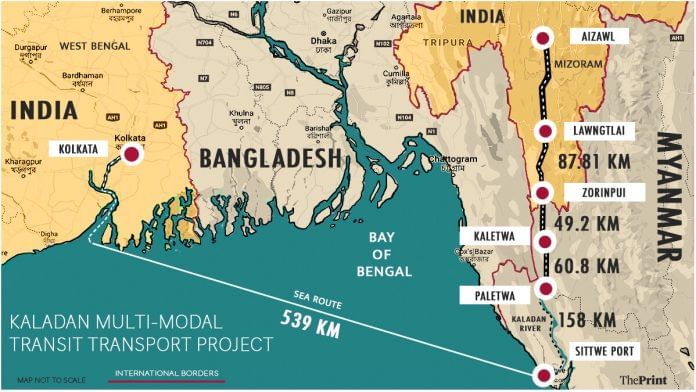Context:
India’s ambitious Kaladan Multimodal Transit Transport Project (KMTTP) is progressing steadily and is expected to be operational by 2027. This project, linking India’s eastern ports to the Northeast through Myanmar, is a major step in improving connectivity, boosting regional trade, and strengthening strategic influence in Southeast Asia.
Once complete, the project will reduce the distance between Kolkata and Aizawl by about 700–1,000 km. This will cut transport costs and time by over 50%, making trade more efficient and accessible for the landlocked northeastern states.
Key Features of KMTTP:
The Kaladan project was first conceptualized to overcome the severe geographic isolation of India’s Northeast Region (NER), which is connected to the rest of the country only by the narrow Siliguri Corridor, often called the “Chicken’s Neck.”
The framework agreement for the Kaladan Project was signed in 2008. The Ministry of External Affairs serves as the nodal agency, while the Inland Waterways Authority of India is the Project Development Consultant.
The project has two main transit components:
- Waterway Component: Cargo will be shipped from Sittwe Port in Myanmar up the Kaladan River to Paletwa.
- Road Component: Goods will be transported by road from Paletwa to Zorinpui on the India-Myanmar border in Mizoram.
Strategic and Economic Importance:
- Reducing Dependence on the Siliguri Corridor: The Siliguri Corridor is only 21 km wide and is vulnerable to blockades during conflicts or natural disasters. Kaladan offers an alternative route that reduces this dependence.
- Less Reliance on Bangladesh: Although Bangladesh has cooperated with India on transit, having an independent route through Myanmar strengthens India’s logistical security.
- Boosting Act East Policy: The project supports India’s Act East Policy, which aims to improve connectivity and economic integration with Southeast Asia.
- Counterbalancing China: China is developing the China-Myanmar Economic Corridor (CMEC). The Kaladan project helps maintain India’s strategic presence in Myanmar and counters growing Chinese influence.
- Economic Development: The project is expected to transform the Northeast into a trade and business hub. Sectors such as manufacturing and agro-processing stand to benefit. Reduced travel time will also promote tourism and regional integration.
Other Connectivity Initiatives:
- India-Myanmar-Thailand Trilateral Highway: Connecting Manipur in India to Thailand via Myanmar.
- Protocol on Inland Water Transit and Trade: An agreement between India and Bangladesh that allows inland vessels to use each other’s waterways.
- Bangladesh-Bhutan-India-Nepal Motor Vehicle Agreement: Facilitating regional road connectivity.
- Use of Chattogram and Mongla Ports: Agreements with Bangladesh to access key ports for cargo movement to the Northeast.
Conclusion:
The Kaladan Multimodal Transit Transport Project is a landmark infrastructure initiative that will significantly reshape India’s Northeast. By providing an alternative route to the vulnerable Siliguri Corridor, it enhances national security and trade resilience. The project also aligns with broader strategic goals under the Act East Policy and serves as a counterbalance to regional geopolitical shifts.







